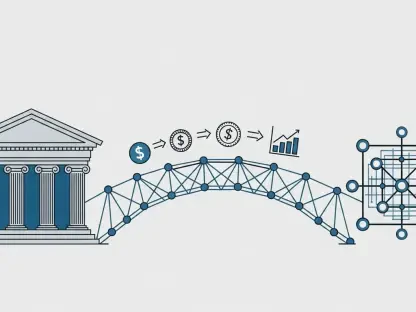I’m thrilled to sit down with Kofi Ndaikate, a seasoned expert in the fintech landscape, whose deep knowledge of credit card networks, consumer spending trends, and economic dynamics offers invaluable insights. Today, we’ll explore American Express’s recent performance, diving into their reported growth in card member spending, the unique nature of their premium customer base, and how they’re navigating economic uncertainties like inflation and potential government shutdowns. We’ll also touch on key sector trends and the company’s overall financial health.
Can you walk us through the 9% increase in card member spending that American Express reported for the third quarter, and what you think fueled this growth?
Absolutely, Jay. That 9% jump in spending is a strong indicator of consumer confidence among Amex’s cardholders. A big driver here is likely the rebound in discretionary spending, particularly in areas like travel and dining, which have seen pent-up demand post-pandemic. Amex’s focus on high-net-worth individuals also means their customers are less sensitive to economic fluctuations, so they’re more likely to keep spending even when costs rise. I’d also point to the effectiveness of Amex’s rewards programs—those points and perks incentivize card usage, especially for big-ticket purchases.
Which regions or customer demographics do you believe played the biggest role in driving this spending increase?
From what I’ve seen, the growth is likely concentrated in urban centers and affluent regions, particularly in the U.S. and parts of Europe, where Amex has a strong foothold with high-income professionals. Millennials and Gen Z cardholders, who are increasingly drawn to premium cards for travel benefits, are also a key demographic. These younger users often prioritize experiences over material goods, so their spending on things like luxury travel or dining out could be a significant contributor to the numbers we’re seeing.
Amex has described their customer base as more premium and not reflective of the broader U.S. economy. How does this shape their approach to business strategy?
Having a premium customer base allows Amex to focus on tailored, high-value offerings rather than competing on volume with mass-market card providers. Their strategy leans heavily on exclusive benefits—think airport lounge access or concierge services—that justify higher fees. It also means they can invest in partnerships with luxury brands and hospitality sectors, aligning with their cardholders’ lifestyles. This niche positioning helps them maintain strong margins, even if it limits their market share in terms of sheer card numbers.
Does focusing on a wealthier segment come with any potential downsides, especially during economic uncertainty?
Definitely. While a premium base offers some insulation from economic downturns, it’s not foolproof. If a severe recession hits, even affluent consumers might cut back on discretionary spending, which is a big chunk of Amex’s revenue stream. Plus, by catering to a smaller, wealthier segment, they risk missing out on growth opportunities in emerging markets or with middle-income consumers who might be drawn to competitors with lower fees or broader accessibility. It’s a trade-off between profitability and scalability.
CEO Steve Squeri pointed to robust spending in hospitality and luxury travel, with front cabin airline ticket purchases up 14% year-over-year. What’s driving this surge in upscale travel?
I think it’s a mix of factors. First, there’s a strong post-pandemic desire for premium experiences—people who delayed vacations are now splurging on first-class or business-class tickets to make up for lost time. Second, Amex cardholders often use their cards for travel to maximize rewards, and the company’s partnerships with airlines make front cabin bookings particularly appealing. Additionally, hybrid work arrangements have blurred the lines between business and leisure travel, so more professionals are opting for comfort on longer trips, especially if their company foots part of the bill.
Restaurant spending also rose by 9%. Is this growth uniform across all dining categories, or are certain types, like fine dining, leading the way?
I’d wager that fine dining and upscale casual restaurants are driving most of this growth, given Amex’s customer profile. Their cardholders are more likely to frequent high-end establishments, especially in major cities, where they can also earn enhanced rewards on dining. That said, I wouldn’t be surprised if quick-service or mid-tier dining saw some uptick too, as even premium customers grab a coffee or casual meal on the go. But the bulk of the 9% increase probably ties to experiential dining—think special occasions or business dinners.
How is Amex positioning itself in light of economic challenges like inflation and the looming threat of a government shutdown?
Amex seems to be taking a proactive stance by diversifying revenue streams and strengthening their corporate card offerings, which can provide stability if consumer spending slows. They’re also likely tightening credit policies to manage risk, ensuring they don’t overextend to customers who might struggle in a downturn. Their messaging suggests confidence in their customer base’s resilience, but they’re not ignoring the broader environment—they’re just betting that their premium focus will buffer them more than competitors.
Are you seeing any signs that these economic pressures are influencing Amex cardholders’ spending behaviors?
Not significantly, based on the data. Amex’s customers appear to be maintaining their spending levels, which ties back to their affluence and the fact that many use these cards for business expenses that aren’t as discretionary. Inflation might pinch some at the margins, but for most of their cardholders, a few extra bucks on groceries or gas isn’t a dealbreaker. If anything, they might shift spending to categories where they get more rewards, rather than cutting back outright.
CFO Christophe Le Caillec mentioned that Amex customers aren’t reacting much to economic strains. Beyond their wealth, what else might be encouraging this steady spending?
Beyond wealth, Amex’s loyalty programs and card benefits are huge motivators. Their rewards structure—whether it’s cashback, travel points, or exclusive perks—creates a strong incentive to keep swiping, even in uncertain times. Additionally, many cardholders view Amex as a status symbol, so there’s a psychological element of maintaining that lifestyle. And for business users, the card often ties to expense accounts, so personal economic concerns don’t directly impact usage. It’s a clever ecosystem that keeps spending consistent.
With a 16% increase in net income and an 11% rise in total revenue for the quarter, what do these figures reveal about Amex’s overall financial strength?
These numbers paint a picture of a company in robust health, especially in a choppy economic climate. The 16% net income growth suggests not just higher spending but also effective cost management and possibly lower credit losses than anticipated. The 11% revenue increase reflects their ability to capitalize on transaction volumes and fees from their premium cards. It’s a sign that their business model—focusing on affluent customers and high-margin services—is paying off, positioning them well against competitors who might be struggling with broader consumer segments.
What specific initiatives or business areas do you think contributed most to these impressive financial results?
I’d point to their push into corporate and small business cards as a key factor. By encouraging companies to use Amex for expenses, they’re tapping into a steady stream of high-volume transactions. Their investments in digital tools and partnerships—like seamless travel booking platforms—also likely boosted engagement and spending. Plus, their focus on hospitality and luxury sectors, where spending is up, aligns perfectly with their customer base, driving both transaction fees and interest income if balances are carried.
Looking ahead, what’s your forecast for American Express’s performance in the coming quarters, especially with ongoing economic uncertainties?
I’m cautiously optimistic about Amex’s trajectory. Their premium customer focus and strong brand loyalty should continue to shield them from broader economic headwinds, at least in the near term. I expect spending in travel and dining to remain solid, though growth rates might taper if inflation persists or if a deeper recession looms. Their push into business payments could be a game-changer, providing a buffer if consumer spending slows. Overall, I see them maintaining steady growth, provided they keep innovating with rewards and digital offerings to retain their high-end clientele.









